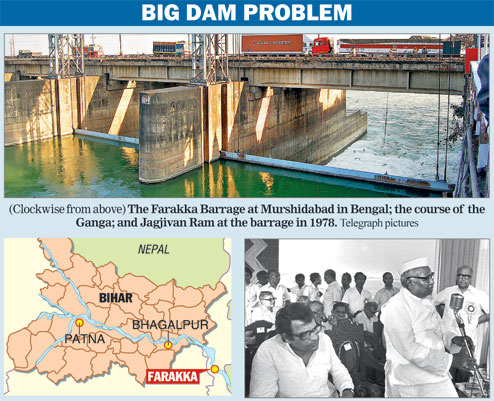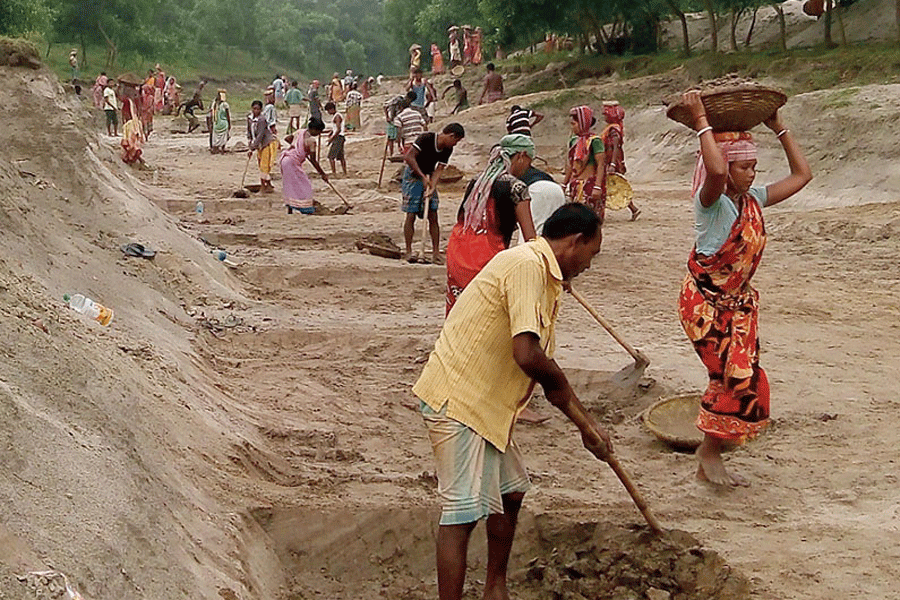Patna, Aug. 22: Environmentexperts agree with chief minister Nitish Kumar’s assertion that the Farakka Barrage in Bengal is to be blamed for heavy siltation in its lower reaches, estimated to be over 20 lakh tonnes per annum, resulting in flooding in Bihar.

“There is heavy siltation in the Ganga, raising its river bed and reducing its water carrying capacity. Another negative aspect is that other tributary rivers also are not able to discharge water properly in the Ganga, leading to further siltation at their mouth. All this is bringing deformity in the entire river network in Bihar,” engineer and flood expert Dinesh Kumar Mishra said.
Mishra added that Himalayan rivers, including the Ganga, are notorious for siltation. Recent studies show that the average depth of the Ganga has decreased by almost 50 per cent from Patna to Farakka in Bengal’s Murshidabad district — a waterway distance of 460km downstream — in the four decades since the barrage was built.
Environmentalist R.K. Sinha, professor of zoology at Patna University known for his research on the Gangetic dolphin, concurred.
“I visited it (Farakka Barrage) three to four times every year from 1991 to 2004 to study the river. I saw huge invasion of macrophytes and filamentous algae since 1991. It had turned the entire pondage green, and was trapping silt heavily leading to quick deposits. I pointed this out to the officials posted there, but they washed their hands of it, saying there were no clear-cut instructions from the Centre’s advisory committee on Farakka,” Sinha said.
“In 2004, I saw a 3km-long and 300m-wide silt island in the pondage area, and it was increasing by the day. Once massive siltation happens, it has a cascading effect backwards leading to siltation all along the route. Embankments aggravated the situation by not allowing slit to spread,” he added.
Pondage — the water accumulation area just behind a barrage — at Farakka was to be 72-foot deep after its commission in 1975. Heavy and huge dredgers were kept for dredging. Silt excluders were provisioned. But none of it could prevent siltation.
Nitish today again blamed the Farakka Barrage for Bihar’s flood woes. “The current flood has not come due to rains as rainfall in Bihar is 19 per cent deficient this monsoon. It has come due to heavy siltation of the Ganga as the Farakka Barrage doesn’t allow silt to pass. This has made the river shallow, narrowed its stream and severely reduced its water retention capacity. As a result even if a little water is released in the river, it spills and spreads as flood,” Nitish said at the launch of Yugantar Prakriti, a monthly magazine on environmental issues published through the initiative of Jharkhand minister Saryu Roy.
Nitish said he has requested Union home minister Rajnath Singh to send a team of “unbiased and impartial environmental experts, scientists and engineers to look into the present condition of the Ganga, suggest immediate steps to address it and begin work urgently, as the situation will recur and worsen in the coming years”.
Rajnath had called up Nitish on Sunday night to take stock of the current flood in the Ganga that has severely affected 12 districts and is threatening the state capital.
Nitish said he has been raising the issue of the Farakka Barrage continuously for the last 10 years at all appropriate forums, including the meetings of the National Ganga River Basin Authority, without any tangible results. “How much benefit has accrued from the Farakka Barrage is known only to the Centre or the states which profited from it. But as far as Bihar is concerned, everything shows that it did not benefit from it in any manner.
At all the meetings I attended during the UPA regime at the Centre, I saw people worrying only about upstream and I used to tell them to think also about downstream, but nothing happened,” Nitish said.
Nitish, who holds a degree in electrical engineering from Bihar College of Engineering, now known as NIT Patna, hit out at engineers who have kept asserting that the barrage has been designed to provide automatic expulsion of silt with the outflow of water.
“Don’t believe the engineers when they say silt does not stop at the barrage and moves out with water discharge there. I have studied engineering and many engineers are my friends. They never tell the truth on siltation. I will keep requesting the Centre to devise a way out, as the state can’t be left with such a big problem in its hands. A national policy on siltation should also be framed,” Nitish added.
Nitish accepted that it may not be possible to destroy or dismantle the Farakka Barrage, but stressed that solutions should be found with the help of experts, engineers, and other stakeholders — all the while keeping in view its political and diplomatic effects.
While the environment experts say the Centre has been silent on the issue and the governments in Ganga riparian states have not done much to stop massive deforestation along the river and conduct forestation campaigns, they also assert that the situation is not beyond recovery.
“Dredgers should be employed to slice away the silt island that has formed in the pondage area behind the barrage, bit by bit, especially during the flood season. The loosened silt will move out of the barrage with water. No time frame could be given to this, but it may take two to four years of work,” said environmentalist Sinha.
He also said that when the flow of water at Farakka increases, the silt deposited in the upstream in Bihar will also start getting pushed forward, and its expulsion from the barrage will have to be ensured.










